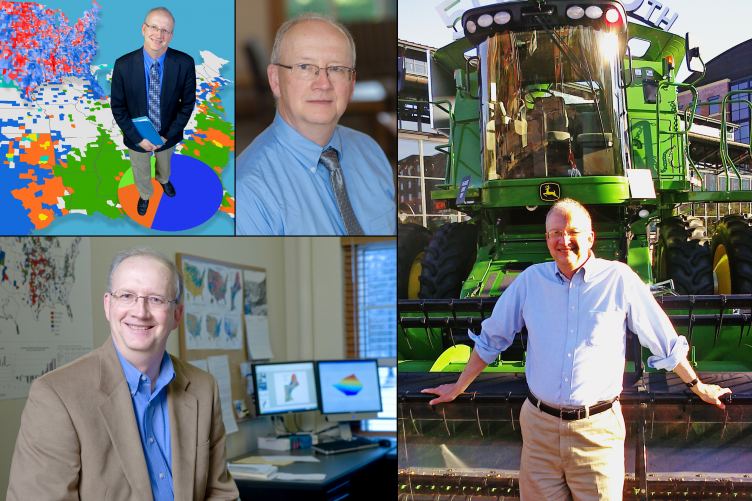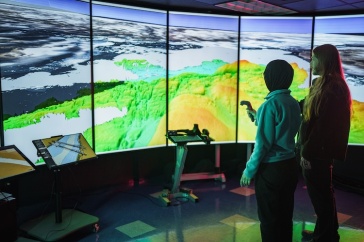
“I once had a reporter jokingly say to me ‘Ken, you were into data analytics before it was cool,’” he says, a smile audible in his voice. “Which, you know, is true.”
Professor Ken Johnson has spent decades deep in the numbers of American demographics. Today he holds a joint appointment with the Carsey School and as a member of the Sociology Department of UNH’s College of Liberal Arts. Whether he is working at his computer, conducting interviews in the field, or leading a classroom of students, he has built a career of using population statistics to get a grasp on our ever-evolving country. Among the many changes the U.S. has experienced over the course of his career is a growing appreciation of the power of statistics. The world is finally catching up to what Dr. Johnson has known for a long time: robust and accurate data are an invaluable tool to understand the world around us.
“All through school, I had an interest in numbers and in analyzing data.” As an undergraduate at the University of Michigan in the 1970s, educational options for statistical analysis were few and far between. One of the only areas where the breadth and quality of the data matched Johnson’s boundless curiosity was population statistics. “I did an independent study for my sociology undergraduate major and actually got to look at census data… That's where my interest in demographic phenomena began.”
For that project, Johnson dug into the population of Chicagoland, then the country’s second largest metro area. By comparing the 1950 and 1960 censuses, he found he could track changes not just over time, but also between neighborhoods and across race, income, and education level. Beyond a simple accounting of residents, Johnson found that the data told human stories. What kind of neighborhoods do people want to live in? Whom do they want to create communities with? Who is being left behind?
Johnson stayed in Ann Arbor after his B.A. to continue his work in demography at the University of Michigan’s data center, one of the nation’s largest. From there, he made the jump to Chapel Hill, to pursue a PhD in sociology at the University of North Carolina. Johnson developed a specialty in the statistics of rural areas, dedicating his dissertation to the subject under the supervision of eminent demographer Amos Hawley.
“One day when I was working on my dissertation, [Prof. Hawley] came in and he handed me this new research and said ‘Ken, you better take a look at this.’”
“It's that constant changing that's really interesting to see… [the census] is like Christmas for demographers. I love it.”
For more than a century, the United States’ urban centers had far outpaced their rural counterparts in growth. Up until that point, Johnson’s dissertation had been focused on the impact that population decline was having on rural communities.
“Demographers at the USDA found that for the first time in 150 years, rural America was growing faster than urban America. So I had to sort of change the whole topic of my dissertation: to look at growth and decline in rural America, rather than just decline.” Within a few years, the 1980 census would confirm the early data from the USDA. In remembering those moments, Johnson can’t keep the excitement from his voice. “It's that constant changing that's really interesting to see… [the census] is like Christmas for demographers. I love it.”
The phenomenon would come to be called the Rural Turnaround and Johnson’s interest in it would help guide him on the path that led him to where he is today. That first report indicating a resurgence in rural population growth was conducted by a demographer named Calvin Beale, with whom Johnson would later co-author several articles.

“We used to call him the Michael Jordan of rural demography. He knew more about rural America than anyone that I have ever met.”
When looking back on their collaborations, Johnson stressed that what made Beale’s work so extraordinary wasn’t simple information recall, it was the connections he made between the statistics and the actual lives of the people who make up the numbers. He could engage any resident in the field in conversation by establishing a sense of shared understanding and use that knowledge to help make sense of their community.
“He might say ‘This county grew a lot in the 1890s because when the Germans came in, they settled in the valleys, whereas the Swedes and Norwegians preferred the hill edges because they’re used to that…’ He could add a whole story to demographic data.”
It’s a skill that Johnson has carried forward throughout his career as both a researcher and educator. After earning his PhD, he taught for more than twenty years at Loyola University in Chicago, during which time he became a prominent voice in any national discussion on demographic change. Johnson knows to expect a flurry of calls from reporters whenever the latest batch of census data is released; he understands the important role he gets to play in how the public understands the country.
“I've spoken to everything from second graders, to the Illinois Bar Association, New Hampshire Legislative Sessions, and at Congressional Briefings… Demography is an important lens to understanding much of what is happening and what has happened to the country.”
“I've spoken to everything from second graders, to the Illinois Bar Association, New Hampshire Legislative Sessions, and at Congressional Briefings… Demography is an important lens to understanding much of what is happening and what has happened to the country.” Johnson speaks with the calm assuredness one expects from a veteran professor, but his passion is still evident in every illustration. "Even if you're not interested in the intricacies of a specific fertility or age migration pattern, the fact that young people are moving to or moving away from your community has implications that ripple through the core things that make a community a community. Decade after decade, that has implications for the communities that are left behind and for the people who are left behind.”
Rural America has remained one of Johnson’s specialties and it was on this subject in 2006 that he wrote his first report for Carsey. It was the beginning of an illustrious chapter in his career: Johnson has gone on to publish over 70 research briefs for the school, as well as numerous scholarly articles, and has been honored with an Andrew Carnegie Fellowship. He joined the faculty of UNH in 2007, where he has been ever since, teaching the next generation of demographers and helping us all feel the importance of (and excitement for) population statistics.
“To get to see all these data as they come out: how the country’s changing and how it's staying the same… the action of all that information flowing has always been my excitement. No, really! I've been through a lot, but I still get psyched up on the day that census data are going to be released. You're seeing a part of the story of the country.”
Reported by Benjamin Scott Savard ‘23

















































